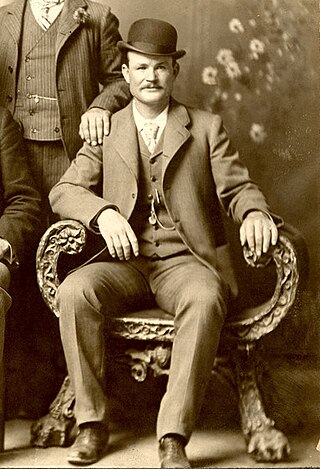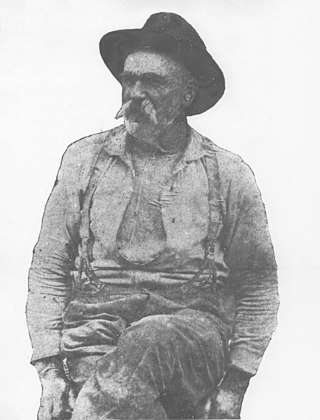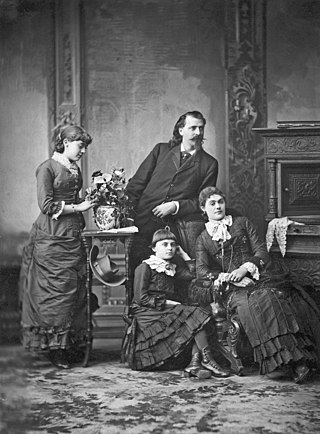
William Frederick Cody, known as Buffalo Bill, was an American soldier, bison hunter, and showman. He was born on Prince Edward Island, Canada but he lived for several years in his father's hometown in modern-day Mississauga, Ontario, Canada, before the family returned to the Midwest and settled in the Kansas Territory.

Robert LeRoy Parker, better known as Butch Cassidy, was an American train and bank robber and the leader of a gang of criminal outlaws known as the "Wild Bunch" in the Old West.

The Bighorn Basin is a plateau region and intermontane basin, approximately 100 miles (160 km) wide, in north-central Wyoming in the United States. It is bounded by the Absaroka Range on the west, the Pryor Mountains on the north, the Bighorn Mountains on the east, and the Owl Creek Mountains and Bridger Mountains on the south. It is drained to the north by tributaries of the Bighorn River, which enters the basin from the south, through a gap between the Owl Creek and Bridger Mountains, as the Wind River, and becomes the Bighorn as it enters the basin. The region is semi-arid, receiving only 6–10 in (15–25 cm) of rain annually.

The Buffalo Bill Center of the West, formerly known as the Buffalo Bill Historical Center, is a complex of five museums and a research library featuring art and artifacts of the American West located in Cody, Wyoming. The five museums include the Buffalo Bill Museum, the Plains Indians Museum, the Whitney Western Art Museum, the Draper Natural History Museum, and the Cody Firearms Museum. Founded in 1917 to preserve the legacy and vision of Col. William F. "Buffalo Bill" Cody, the Buffalo Bill Center of the West is the oldest and most comprehensive museum complex of the West.

John "Liver-Eating" Johnson, born John Jeremiah Garrison Johnston, was a mountain man of the American Old West.
The Battle of Warbonnet Creek was a skirmish characterized by a duel between "Buffalo Bill" Cody and a young Cheyenne warrior named Heova'ehe or Yellow Hair. The engagement is often referred to as the First Scalp for Custer. It occurred July 17, 1876, in Sioux County in northwestern Nebraska.
Western lifestyle or cowboy culture is the lifestyle, or behaviorisms, of, and resulting from the influence of, the attitudes, ethics and history of the American Western cowboy. In the present day these influences affect this sector of the population's choice of recreation, clothing, and consumption of goods.

Wild West shows were traveling vaudeville performances in the United States and Europe that existed around 1870–1920. The shows began as theatrical stage productions and evolved into open-air shows that depicted romanticized stereotypes of cowboys, Plains Indians, army scouts, outlaws, and wild animals that existed in the American West. While some of the storylines and characters were based on historical events, others were fictional or sensationalized.
Buffalo Bill is a 1944 American Western film about the life of the frontiersman Buffalo Bill Cody, directed by William A. Wellman and starring Joel McCrea and Maureen O'Hara with Linda Darnell, Thomas Mitchell, Edgar Buchanan and Anthony Quinn in supporting roles.
Charles William Kingston was a member of the Latter Day Church of Christ and the Davis County Cooperative Society.

The Reference and User Services Association (RUSA), is a network to educate, empower, and inspire its members to advance the evolution of the profession and better serve users in a continuously changing information society. It is a Division of the American Library Association.
W. Hudson Kensel was an historian and author of the American West. He is professor emeritus from California State University at Fresno.
The T E Ranch Headquarters, near Cody, Wyoming, is a log ranch house that belonged to buffalo hunter and entertainer Buffalo Bill Cody (1846–1917). The house may have originally been built by homesteader Bob Burns prior to 1895, when Cody acquired the ranch. Cody expanded the ranch to about eight thousand acres (32 km2), using the T E brand for his thousand head of cattle.

Buffalo Bill – The Scout is a bronze statue of a mounted rider outside the Buffalo Bill Historical Center in Cody, Wyoming, United States, that was placed in 1924 to commemorate the town's most famous resident and de facto founder, Buffalo Bill Cody. Originally in open land on the western outskirts of Cody, the statue now stands at the end of Sheridan Avenue, which became the town's main thoroughfare as Cody grew to the west. The project was initiated by Buffalo Bill Cody's niece, Mary Jester Allen, who had established the basis of what would become the Buffalo Bill Historical Center. A New Yorker, she persuaded heiress and artist Gertrude Vanderbilt Whitney to sculpt the piece.
Thomas C. Molesworth (1890–1977) was an American furniture designer who was a significant figure in the creation of a distinctly Western style of furniture and accessories, using hides, horn and natural wood. Molesworth's style drew from the Arts and Crafts Movement and from vernacular design characteristics of western American ranches and farms. He is credited with popularizing the "cowboy furniture" style. To produce his designs, Molesworth operated the Shoshone Furniture Company from 1931 to 1961 in Cody, Wyoming with his wife, LaVerne Johnston Molesworth.

The following works deal with the cultural, political, economic, military, biographical and geologic history of pre-territorial Wyoming, Wyoming Territory and the State of Wyoming.

Louisa Maud Frederici Cody was the wife of William F. "Buffalo Bill" Cody. She married on March 6, 1866, on her family farm in Arnold, Missouri, and remained in a rocky relationship for 51 years until Cody's death in 1917. The couple had met when Cody traveled to St. Louis due to his Union Army duties at the close of the Civil War. They married soon after, the wedding taking place shortly after their interactions in 1865, with Cody taking time out from scouting and horse-driving to marry Louisa. Louisa, often referred to as "Lulu" by her husband, was a proud woman who would not simply grant Cody a divorce in 1904, which led to trial in 1905. The case was given in Louisa's favor after a judge deemed "incompatibility was not a grounds for divorce."

Henry Inman was an American soldier, frontiersman, and author. He served the military during the Indian campaigns and the American Civil War, having earned distinction for gallantry on the battlefield. He was commissioned lieutenant general during the Indian wars. He settled in Kansas and worked as a journalist and author of short stories and books of the plains and western frontier. He was a friend and associate of Buffalo Bill and served under General Custer.
Jesse James Under the Black Flag is a 1921 American silent Western film directed and written by Franklin B. Coates. It is about the bandit Jesse James, who is portrayed by his son Jesse James Jr.










